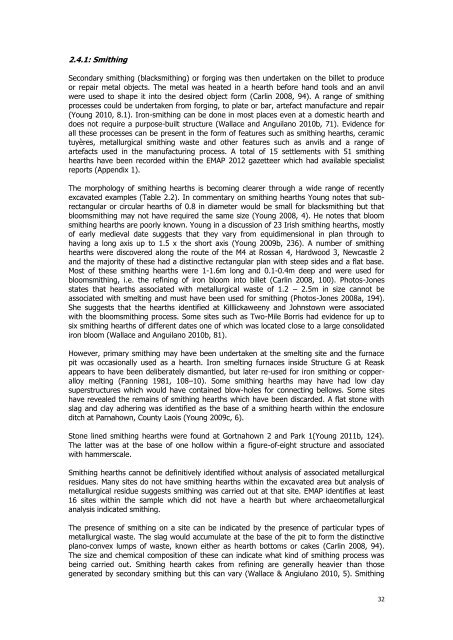EMAP_2012_Report_6_1.pdf (7.3 MB) - The Heritage Council
EMAP_2012_Report_6_1.pdf (7.3 MB) - The Heritage Council
EMAP_2012_Report_6_1.pdf (7.3 MB) - The Heritage Council
Create successful ePaper yourself
Turn your PDF publications into a flip-book with our unique Google optimized e-Paper software.
2.4.1: Smithing<br />
Secondary smithing (blacksmithing) or forging was then undertaken on the billet to produce<br />
or repair metal objects. <strong>The</strong> metal was heated in a hearth before hand tools and an anvil<br />
were used to shape it into the desired object form (Carlin 2008, 94). A range of smithing<br />
processes could be undertaken from forging, to plate or bar, artefact manufacture and repair<br />
(Young 2010, 8.1). Iron-smithing can be done in most places even at a domestic hearth and<br />
does not require a purpose-built structure (Wallace and Anguilano 2010b, 71). Evidence for<br />
all these processes can be present in the form of features such as smithing hearths, ceramic<br />
tuyères, metallurgical smithing waste and other features such as anvils and a range of<br />
artefacts used in the manufacturing process. A total of 15 settlements with 51 smithing<br />
hearths have been recorded within the <strong>EMAP</strong> <strong>2012</strong> gazetteer which had available specialist<br />
reports (Appendix 1).<br />
<strong>The</strong> morphology of smithing hearths is becoming clearer through a wide range of recently<br />
excavated examples (Table 2.2). In commentary on smithing hearths Young notes that subrectangular<br />
or circular hearths of 0.8 in diameter would be small for blacksmithing but that<br />
bloomsmithing may not have required the same size (Young 2008, 4). He notes that bloom<br />
smithing hearths are poorly known. Young in a discussion of 23 Irish smithing hearths, mostly<br />
of early medieval date suggests that they vary from equidimensional in plan through to<br />
having a long axis up to 1.5 x the short axis (Young 2009b, 236). A number of smithing<br />
hearths were discovered along the route of the M4 at Rossan 4, Hardwood 3, Newcastle 2<br />
and the majority of these had a distinctive rectangular plan with steep sides and a flat base.<br />
Most of these smithing hearths were 1-1.6m long and 0.1-0.4m deep and were used for<br />
bloomsmithing, i.e. the refining of iron bloom into billet (Carlin 2008, 100). Photos-Jones<br />
states that hearths associated with metallurgical waste of 1.2 – 2.5m in size cannot be<br />
associated with smelting and must have been used for smithing (Photos-Jones 2008a, 194).<br />
She suggests that the hearths identified at Killlickaweeny and Johnstown were associated<br />
with the bloomsmithing process. Some sites such as Two-Mile Borris had evidence for up to<br />
six smithing hearths of different dates one of which was located close to a large consolidated<br />
iron bloom (Wallace and Anguilano 2010b, 81).<br />
However, primary smithing may have been undertaken at the smelting site and the furnace<br />
pit was occasionally used as a hearth. Iron smelting furnaces inside Structure G at Reask<br />
appears to have been deliberately dismantled, but later re-used for iron smithing or copperalloy<br />
melting (Fanning 1981, 108–10). Some smithing hearths may have had low clay<br />
superstructures which would have contained blow-holes for connecting bellows. Some sites<br />
have revealed the remains of smithing hearths which have been discarded. A flat stone with<br />
slag and clay adhering was identified as the base of a smithing hearth within the enclosure<br />
ditch at Parnahown, County Laois (Young 2009c, 6).<br />
Stone lined smithing hearths were found at Gortnahown 2 and Park 1(Young 2011b, 124).<br />
<strong>The</strong> latter was at the base of one hollow within a figure-of-eight structure and associated<br />
with hammerscale.<br />
Smithing hearths cannot be definitively identified without analysis of associated metallurgical<br />
residues. Many sites do not have smithing hearths within the excavated area but analysis of<br />
metallurgical residue suggests smithing was carried out at that site. <strong>EMAP</strong> identifies at least<br />
16 sites within the sample which did not have a hearth but where archaeometallurgical<br />
analysis indicated smithing.<br />
<strong>The</strong> presence of smithing on a site can be indicated by the presence of particular types of<br />
metallurgical waste. <strong>The</strong> slag would accumulate at the base of the pit to form the distinctive<br />
plano-convex lumps of waste, known either as hearth bottoms or cakes (Carlin 2008, 94).<br />
<strong>The</strong> size and chemical composition of these can indicate what kind of smithing process was<br />
being carried out. Smithing hearth cakes from refining are generally heavier than those<br />
generated by secondary smithing but this can vary (Wallace & Angiulano 2010, 5). Smithing<br />
32
















